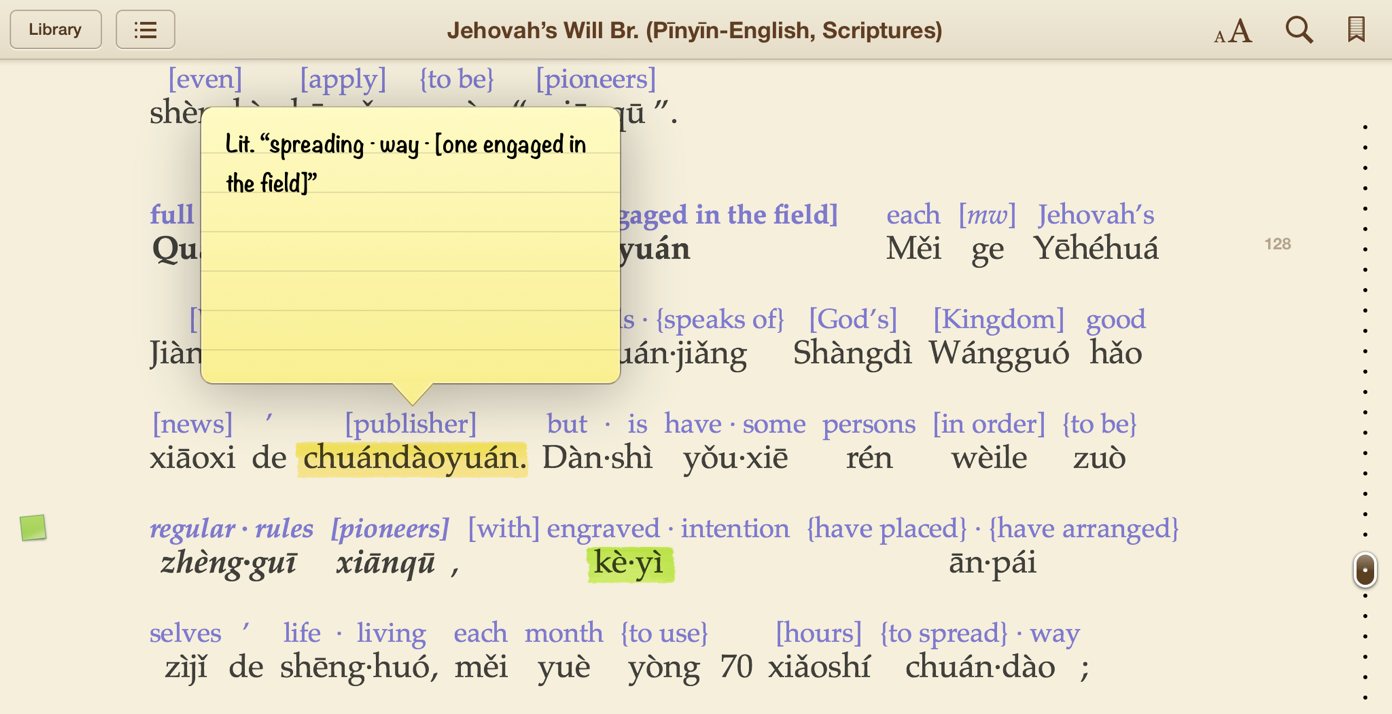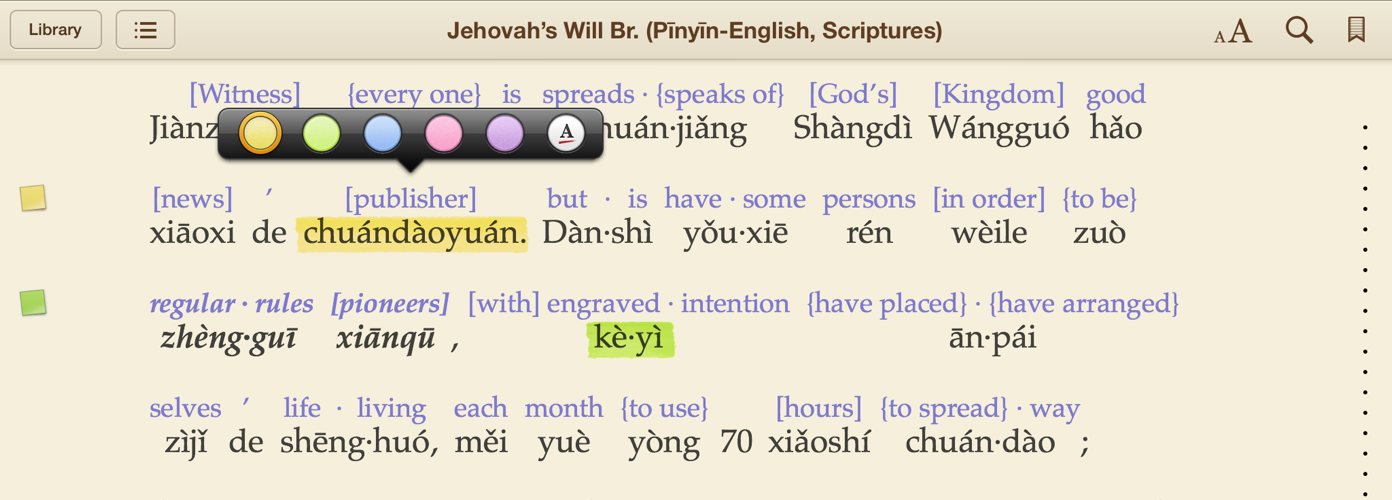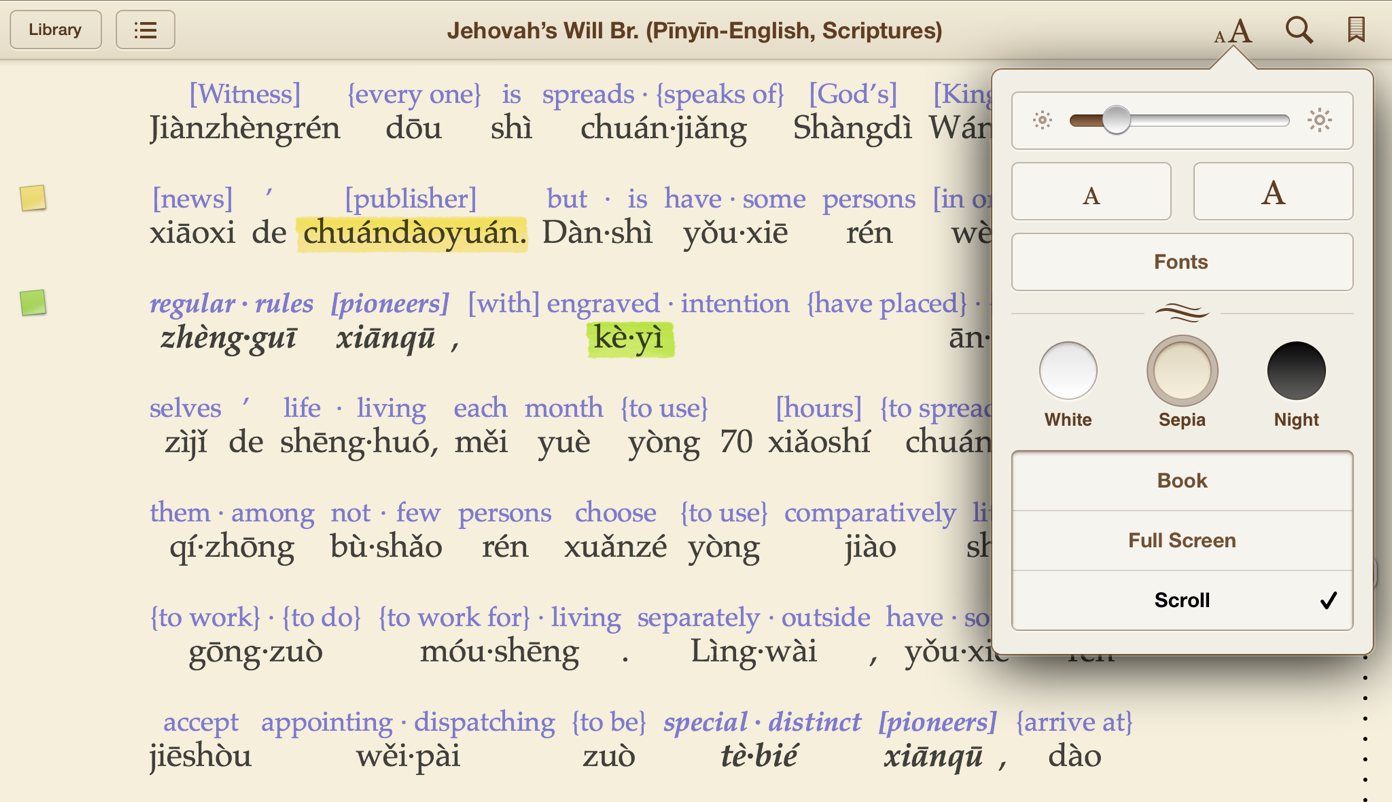 Jehovah’s Will Brochure
Jehovah’s Will Brochure
(Sidney Lau-English, Scriptures EPUB)
Updated 2018-08-03
Short link: tiandi.info/jl
(A list of links related to the Jehovah’s Will brochure)
Contents
- Introduction
- Advantages of the EPUB Format
- Sidney Lau Romanization is a Good, Workable Writing System On Its Own
- Disclaimer
- Proofreading
- Downloading and Opening the File
- Using the File in iBooks
- Updates and Other Information
- Download Link
Introduction
The material in the EPUB file linked to below contains text from the Chinese Jehovah’s Will brochure, written in Sidney Lau romanization. It also includes English ruby text that has been bundled with the Sidney Lau romanization text that it shows the meaning of. Thus, this material provides us Cantonese-learners with assistance in the two language aspects we require in order to be able to discuss or study the Jehovah’s Will brochure with someone in Cantonese:
- The pronunciations of the Cantonese words used
- These show us how to communicate the brochure’s message in Cantonese.
- The meanings of the Cantonese words used
- These show us what is being communicated in Cantonese.
Advantages of the EPUB Format


EPUB annotation in iBooks
Being in EPUB format allows this material to benefit from the advantages of this format, including:
- Broad hardware and software support
- Easy enlarging and automatic reflowing of the text to accommodate displays of various shapes and sizes, including those of many mobile devices
- This is especially an advantage compared to the situation with PDF files, which have preset page sizes and line endings baked in. As a result, PDF files are often cumbersome and difficult to read on smaller mobile devices.
- Offline use
- Since EPUB files have been available from jw.org for a long time, many people in the Chinese field are now familiar with how to download EPUB files and use them offline.
- Annotation (notes, highlighting, etc.) support
- Hyperlinking that is familiar and expected, and that thus will get used and benefitted from
- Taking advantage of this, scripture references in the main text are links to the full text of the cited scriptures. There, links are provided for returning to the referring citations in the main text.
- Links are also provided for “teleporting” from the table of contents to the chapter headings and back.
- As well, links are provided as necessary for going to any footnotes, etc., and for returning from them to the main text.
- Producibility and editability with simpler, more accessible, more mobile tools
- Whereas at this time Microsoft Word running on a desktop or laptop PC is needed to produce satisfactory 3-line material, this plain text-based Sidney Lau-English material can be satisfactorily partly produced and edited with even an app running on a mobile device like an iPad.
Sidney Lau Romanization is a Good, Workable Writing System On Its Own
Reading just Sidney Lau romanization may take some getting used to if you’re accustomed to reading (or trying to read) Chinese characters, but going by first principles of linguistics (the scientific study of language) rather than mere human traditions, it should be more than worth the effort. You should at least give yourself a chance to get used to it.
“One of the basic assumptions of modern linguistics [the scientific study of language]…is that speech is primary and writing is secondary”. Yes, speech is the foundation on which writing must be built, not vice-versa. (That is just a natural result of the way Jehovah made us—he gave our bodies the built-in ability to produce speech, but writing requires external aids such as pens and paper, keyboards and screens, etc.) Thus, it is very good that Sidney Lau romanization represents Cantonese speech so straightforwardly and easily, and that it enables us to focus on speech. Yes, while Chinese characters, as beautiful and traditional as they are, demand distractingly large commitments of precious time and energy just for themselves, Sidney Lau romanization frees and empowers us to focus on communicating the good news.
Indeed, in our ministry specifically, we definitely need understanding what we hear and speaking much more than we need reading and writing. So, while many who have received traditional Cantonese language instruction have been influenced to believe that being able to read and write characters is the ultimate goal for a Cantonese language student to aspire to, actually, for us Kingdom publishers, our ultimate goal regarding Cantonese should be being able to understand and speak spoken Cantonese, so that we can preach and teach the good news effectively using Cantonese. So, really, to us Kingdom publishers, being able to read, understand, and write Sidney Lau romanization, which directly represents Cantonese speech, is a more relevant and important (and easy-to-achieve) goal to aspire to than being able to read, understand, and write characters, which unfortunately have become this thing on their own that has warped and obfuscated Cantonese speech rather than supporting it.
But, is Sidney Lau romanization even really a writing system? Interestingly, the Chinese national standard Zhōngguó Mángwén (中国盲文/中國盲文, Chinese Braille) is basically a transliteration or conversion of Pīnyīn into braille letters. Braille is obviously a writing system, so Pīnyīn must also be a writing system, not just a pronunciation aid. Since Pīnyīn must be a writing system, then Sidney Lau romanization, a phonographic system like Pīnyīn is, must also be a writing system. (A phonographic writing system is one in which the symbols represent the basic sounds of the language.)
Also, as a Sumerian proverb stated, “a scribe whose hand matches the mouth, he is indeed a scribe”. Sidney Lau romanization can indeed be used to write anything that can be spoken in modern Cantonese, so it qualifies as a full writing system in that fundamental sense as well.
(That Sidney Lau romanization is a full writing system for any and all modern Cantonese speech also means that, in addition to it being correct to say that “Sidney Lau romanization is Chinese” because it was developed in Hong Kong by a Chinese person, it is also quite correct to say that “Sidney Lau romanization is Chinese” in the sense that, even if it isn’t Chinese characters, it is indeed written Cantonese Chinese—it’s not as if Sidney Lau romanization were written English or French or something!)
Really, after a bit of research into what the definition of a “writing system” is, it becomes evident that a system like Sidney Lau romanization should naturally be considered a writing system, in spite of the efforts of worldly Chinese intellectuals to artificially and unjustly keep systems like Sidney Lau romanization down in order to protect and enshrine the traditional character writing system that they have so much invested in.
Since Sidney Lau romanization is not just a pronunciation aid, but a full writing system, it is not “training wheels”—it’s regular wheels. Chinese characters are like non-round wheels—more difficult than necessary. While some may find non-round wheels “interesting”, or maybe even “beautiful”, much of the time we just need to get from point A to point B as quickly and easily as possible. We may even need to do so to save someone’s life. For example, what kind of wheels should be on an ambulance? That’s the kind of “wheels” we should be using in our life-saving work.
Practically speaking, we should keep in mind that, as many in the Cantonese field have found, by investing the minimal amount of time and effort needed to learn and get used to the Sidney Lau romanization system, we will be equipped to always be able to quickly and easily read anything in Cantonese that’s written in Sidney Lau romanization, and we will always be able to quickly and easily write anything in Cantonese using Sidney Lau romanization. In contrast, even those who are fairly familiar with Chinese characters will at times come across unfamiliar or forgotten characters whose meanings and pronunciations they can only guess at. Also, even those who are fairly familiar with Chinese characters will at times be completely unable to remember or figure out how to write a certain character.
(By the way, since, as mentioned above, the Sidney Lau romanization system was developed in Hong Kong by a Chinese person, it is a product of Chinese culture, and it is a part of Chinese culture. So, using Sidney Lau romanization is not an imposition of Western culture—it is an application of Chinese culture! Anyway, the most important thing to us should not be mere human cultures or traditions, but what works best for Jehovah’s work.)
For a more in-depth discussion about how we in the Chinese field should view Pīnyīn, and in principle, other phonographic writing systems such as Sidney Lau romanization, see the article “Pīnyīn Was Plan A”. Here is a quote from it:
“That there are so many different words in modern Mandarin that sound the same is not a good reason not to use Pīnyīn, any more than it is a good reason not to speak Mandarin.”
(The login information required is the same as for anywhere else on 3lines.org. If you’re already on the 3lines.org site, you can find this article in the folder Misc ▶ Articles.)
Disclaimer
This is not a publication of the Watchtower Bible and Tract Society, and if a Jehovah’s Will brochure is available, this material should be used along with it, not instead of it. This material is only meant to help those who are learning Cantonese, so that they can more quickly become more effective in the Cantonese field.
IMPORTANT: Please do not use this material as an excuse or as a crutch to just “get by” or “muddle through” at Chinese meetings or Bible discussions. By all means, make good use of this material in such settings, but most importantly, use this material to help you really improve your knowledge and understanding of the Chinese language, so that you can 1) listen with more understanding and 2) speak more effectively from your heart while praising Jehovah and preaching and teaching the good news in the Chinese field.
Proofreading
While some recent 3-line, etc. material has been released by others without it being proofread (which does have the benefit of allowing the material to be released more quickly), the English content in this Jehovah’s Will brochure material has been carefully translated and proofread. Thus, those who are learning Cantonese can reliably use it to help increase their insight into the meanings of Cantonese expressions, as well as their insight into how these expressions are used in various contexts. The Sidney Lau content has been partially proofread. If you find any errors in this Sidney Lau-English material, please email me to let me know.
Downloading and Opening the File
To download and open the file on a PC or a Mac:
- Right-click on the download link below and select Save Link As..., or Save Target As..., or Download Linked File As..., or something similar depending on your browser.
- Select a folder on your hard drive to save the file to and click the Save button or something similar to proceed with the download.
- There are many apps with which one can view and annotate EPUB files on Windows, Mac, and Linux personal computers. For example, Apple’s iBooks app can now run on the Mac.
To download and open the file on an iPad, iPhone, or iPod touch:
- If iBooks is not already installed, go here to download and install it from the App Store.
- In Safari, tap on the download link below.
- Tap on the Open in “iBooks” button that appears.
Using the File in iBooks

Selecting the Scroll theme in iBooks
- iBooks must be running on iOS 6 or newer for it to be able to properly render the wordspacing. (Any version of iBooks that will run on a Mac should work fine too.)
- On iOS devices, go to the Settings app, iBooks section, and turn off Full Justification.
- In iBooks, use the Sepia or White theme to let the English ruby text be shown in a different colour. (The Night theme changes all the text to be the same colour.)
- On smaller devices like the iPhone, using Scrolling View in landscape orientation is especially highly recommended.
Updates and Other Information
Check the Links News blog (news feed, Twitter) for news regarding updates to this and other Chinese field resources. You may also find it interesting to check out the tiandi.info blog (news feed, Twitter), which is about various things related to the Chinese field. (Email me if you need login information, and include information on who referred you and/or what group/cong. you are in.)
If you have any questions or comments, email me.
I hope you enjoy using the material. May it help you to serve more effectively and joyfully in the Cantonese field.
Download Link
Jehovah’s Will Brochure (Sidney Lau-English, Scriptures) EPUB
(Front Cover to Lesson 7;
English proofread, Sidney Lau partially proofread;
mobile-friendly; supports offline use & annotation)